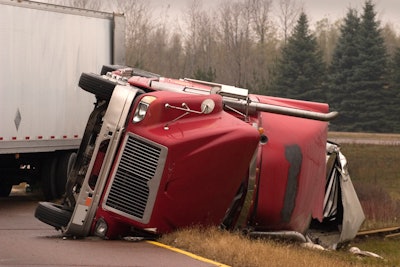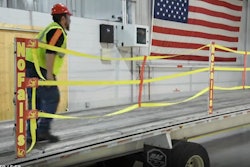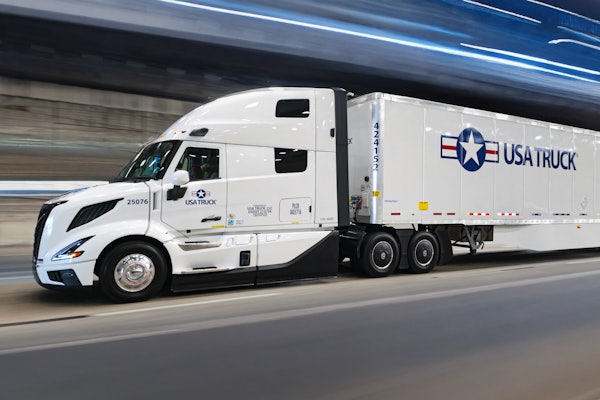
Trucks don’t just jackknife. There is a root cause.
From news reports it sounds like trucks were not designed to brake hard when it is raining. To me, this sounds ridiculous. To many people, the combination of rain, a rookie driver and having to brake hard are the root cause of jackknifing tractor trailers.
All the aforementioned factors can (and do) contribute to jackknifing. But they are not the root cause. Root cause is the one thing that, if perfect, wouldn’t have allowed the rain and the hard braking to make the vehicle go out of control.
In a LinkedIn post, a reader – trying to prove my root cause analysis incorrect – sent me a picture of a major rental and leasing company’s trailer. The picture was of the corner of the trailer where there’s a warning sign that reads, “Tires: 95 PSI minimum." Just one PSI, regardless of load, that’s the root cause of the problem. When someone rents an empty trailer at that pressure, the driver doesn’t stand a chance of avoiding jackknifing under the right circumstances.
A professional in the trucking industry with more than 20 years experience couldn’t believe 95 PSI was incorrect except when the trailer was 100% loaded.
The PSI for a trailer in a rental fleet should at least express some concern for safety by posting: 95 PSI minimum when fully loaded. 65 PSI maximum when empty.
When in-between, take your best guess or consult the tire manufacturer’s load to inflation table.
Admittedly my sign is a little wordier, but this could spark a safety discussion and give the driver time to pause and reflect about his safety situation. Maybe the driver would consider staying on side roads at 45 MPH instead of the interstate at 65 when driving on over inflated tires.
18-wheeler load dynamics are different than a car or light truck.
“Bob, what you’re saying is the trucking industry needs to change tire air pressure as the load changes?” A quote from a trucker who refused to believe what I was telling him.
Tire manufacturers publish load-to-inflation charts for every commercial truck tire. The charts indicate for every change in load, what the change in tire PSI should be. The point of the chart is not to make a trucker’s life harder than it is, but to prevent jackknifing and provide maximum braking on wet or dry pavement.
The tire footprint is determined by the load to inflation. There is a perfect tire footprint, and then there is one too small and one too big. A too small footprint is the root cause of jackknifing.
But the jackknifing is reported as anything but a tire problem. It’s a raining problem. It’s a driver problem. And it’s a truck with a braking problem.
A too big tire footprint, now that’s a tire problem. The tire will soon become a road gator. A big tire footprint at highway speed will have too much friction on the pavement and get hot. The heat from the friction will cause the tire to separate. Someone, somewhere, at sometime, decided that it was a better compromise to have jackknifing trucks than to have road gators.
The reason I am very specific by saying “at highway speed” is because if the vehicle was off-road at twenty miles an hour, the frictional heat would not be a problem.
This is the big tire problem that must be avoided at all costs by fleet tire managers. But what is the cost of this game of trading road gators for jackknifing trucks? The cost of hiding tire mismanagement should include the cost to society of interstate highways being closed to all traffic for hours, and what is the cost of the lives lost?
Road gators are bad because the road gator doesn’t just fly to the side of the road when it leaves the truck. It must be hit several times to move across all lanes of traffic, causing major damage to vehicles and people.
The trucking industry has had an excuse for not following tire manufacturers’ recommendations: It’s just too hard.
The trucking industry can’t get the drivers to even check to see if the tires are at the wrong PSI, let alone calculate the correct PSI and then adjust the tire pressure accordingly.
I get the impression that trucking is an industry that thinks building autonomous trucks is viable, but building autonomous tire inflation and management systems doesn’t make economic sense, or is just too hard. I hope one day the autonomous lobby will read this article and think, "maybe we should have safe tires on our new fancy driverless trucks?"
I hope you agree that a jackknifed truck’s root cause is having the wrong tire footprint. Just because it is reported that a car cut off a truck in the rain and the rookie hit the brakes, doesn’t make it so.
While we’re at it, consider a tangent issue to the tire footprint. A footprint that is bouncing like a beach ball exacerbates the problem. Some people in the trucking industry got it in their heads that trailer tires don’t need to be balanced. So now the too small footprint is bouncing down the road. The footprint not touching the road has become part of the root cause problem. But I digress, more about zero-out-of-balance wheel ends and worn out shock absorbers in the near future.











